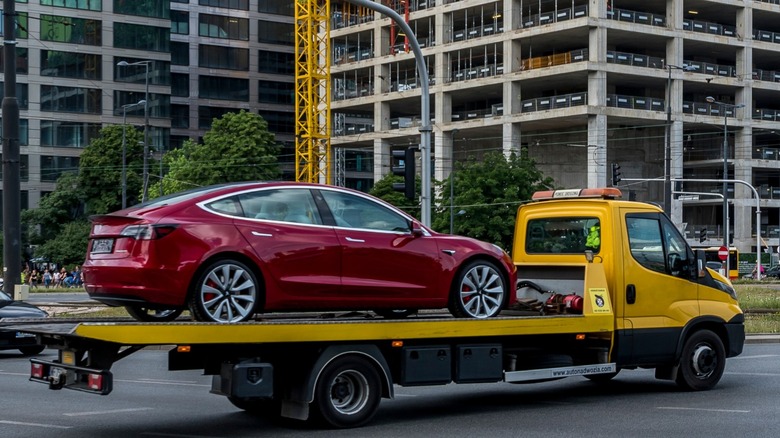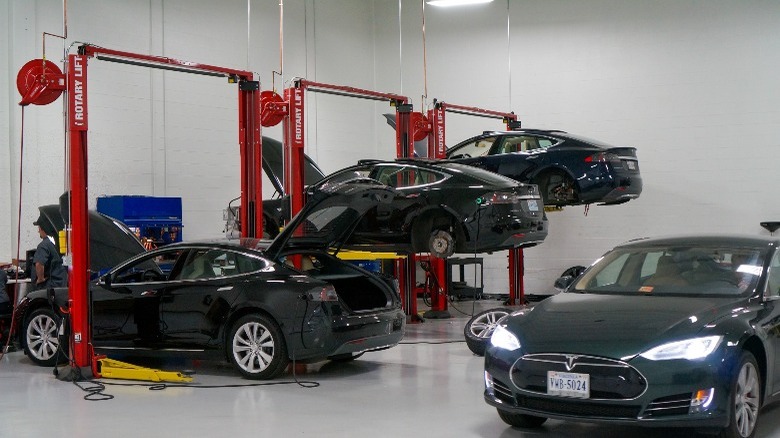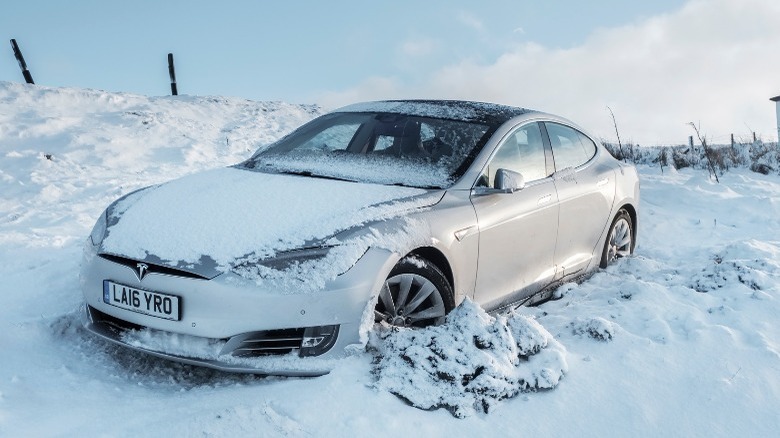Here's What Tesla Roadside Assistance Actually Covers (And What It Doesn't)
Roadside assistance can be an unsung hero when you get stuck with something like a flat tire or a dead battery, especially in vehicles from the likes of Tesla, which come with no spare wheel and can't drive when the battery is dead. When you buy a new Tesla from a Tesla dealership, you get a four-year or 50,000-mile New Vehicle Limited Warranty, which includes Tesla Roadside Assistance for the duration of the warranty period. Used vehicles are a little more complex, but used vehicles also come with a warranty that also includes Roadside Assistance, depending on the vehicle's mileage. Vehicles covered by the Extended Service Agreement also have Roadside Assistance coverage.
Tesla's Used Vehicle Limited Warranty is the balance of the vehicle's original New Vehicle Limited Warranty, plus one year or 10,000 miles of warranty coverage after the original New Vehicle Limited Warranty has run out. If the New Vehicle Limited Warranty has already run out, Tesla warrants the vehicle for one year or 10,000 miles. The Roadside Assistance is offered as long as the vehicle is under warranty, and there is a Tesla dealership or service center in the country. Depending on the price of the vehicle, the peace of mind offered by roadside assistance — and the additional warranty coverage, of course — might make it worth spending a little extra on a slightly newer used model — or even a completely new one, if you can afford it.
What does Tesla Roadside Assistance cover?
Tesla's Roadside Assistance, per Tesla [PDF], offers coverage for the basic issues that are most likely to arise, as well as towing in certain situations. Everywhere except China — where towing distance is unlimited — Tesla covers the first 500 miles of towing, after which any additional distance towed is paid by the driver. Importantly, towing is only covered by Tesla if the issue that immobilized the vehicle is determined to be covered under warranty, otherwise it's the driver's responsibility to pay for the towing service.
Flat tires and damaged wheels are covered under Tesla's Roadside Assistance policy. In the case of a flat, the provider will bring a loaner wheel and install it on the vehicle and take the damaged tire to a service center for repair. The loaner wheel can be used for up to three days, and arrangements should be made with the local service center to exchange the loaner for the original wheel. It should be noted that it's up to owners to provide the operator of the tow service with detailed towing instructions from the Roadside Assistance Guide in the glovebox. This is important, because Tesla will not cover any damage caused by towing.
Tesla's Roadside Assistance also includes a Lockout Service, where a technician will be sent out to unlock a car that's experiencing a malfunction resulting in the driver being locked out of the car. The service is limited, and lockouts are only covered if the vehicle is offline or if it cannot be remotely unlocked by Tesla or the driver. If all else fails, the service provider can also tow your vehicle up to 50 miles to the nearest service center to provide assistance there. If it needs to be towed further, the driver will need to pay for the difference.
What doesn't Tesla Roadside Assistance cover?
The list of items not covered by Tesla's Roadside Assistance [PDF] is, as you might imagine, longer than the list of items covered. In short, Tesla's Roadside Assistance doesn't cover anything except for the aforementioned warrantable issues, flat tires, and Lockout Service. Things like acts of god, vandalism, abuse, negligence, and hazardous weather or driving conditions are all off the table. There are more nuanced exclusions as well, like transportation of yourself or your vehicle from the Tesla Service Center after completion of the repairs. Tesla also doesn't cover long-distance transportation of trailers, caravans, animals, or livestock during a situation where assistance is needed.
On the one hand, you would think electric vehicle "breakdowns" would be common due to running out of battery, but research in the UK shows that only 4% of EV breakdowns are related to battery charge (via Motoring Electric). The most common problems that leave electric vehicles stranded are the same as the ones that most commonly leave ICE vehicles stranded — flat tires and 12-volt batteries. This seems to be where Tesla's Roadside Assistance is most lacking, since it doesn't cover failure of the 12-volt battery or high-voltage battery.
Tesla also doesn't offer transportation of the vehicle in cases where the driver is locked out and doesn't have the key on them, which is almost certainly a protection against theft and bad actors.


